General Questions About Tungsten Carbide
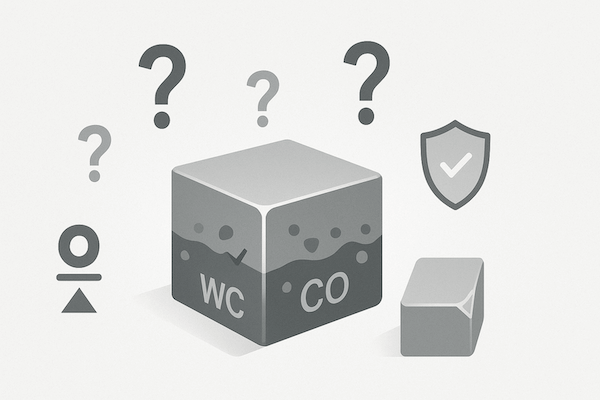
1. What is tungsten carbide?
Answer: Tungsten carbide is a hard, dense compound made from tungsten and carbon atoms. It is renowned for its exceptional hardness, wear resistance, and durability, making it ideal for various industrial applications.
2. How is tungsten carbide different from regular steel?
Answer: Tungsten carbide is significantly harder and more wear-resistant than regular steel. It maintains its sharpness longer and can withstand higher temperatures and abrasive conditions, making it suitable for demanding applications.
3. What are the primary components of tungsten carbide?
Answer: Tungsten carbide primarily consists of tungsten (W) and carbon (C) in a 1:1 ratio. It often includes a metallic binder, such as cobalt, to enhance its toughness and durability.
4. How is tungsten carbide manufactured?
Answer: Tungsten carbide is typically produced through a powder metallurgy process. This involves mixing tungsten carbide powder with a binder metal, compacting the mixture, and then sintering it at high temperatures to form a solid, hard composite.
5. What are the key properties of tungsten carbide?
Answer: Key properties include extreme hardness (8.5-9 on the Mohs scale), high wear resistance, excellent thermal stability, good corrosion resistance, and high tensile strength.
6. Why is tungsten carbide used in industrial applications?
Answer: Its exceptional hardness, wear resistance, and ability to maintain sharpness under high-stress conditions make it ideal for cutting, drilling, machining, and wear-resistant components in various industries.
7. Is tungsten carbide recyclable?
Answer: Yes, tungsten carbide can be recycled. Worn-out tools and scrap material can be reclaimed and reused, reducing waste and conserving resources.
8. What industries commonly use tungsten carbide tools?
Answer: Industries include mining, oil and gas, aerospace, automotive, metalworking, electronics, paper and pulp, and battery manufacturing.
9. Can tungsten carbide be coated with other materials?
Answer: Yes, tungsten carbide can be coated with materials like titanium nitride (TiN) to enhance its properties further, such as increasing hardness or providing additional corrosion resistance.
10. What is the hardness of tungsten carbide compared to diamond?
Answer: Tungsten carbide has a hardness of 8.5-9 on the Mohs scale, which is slightly lower than diamond, which ranks at 10. However, tungsten carbide is more resistant to fracture than diamond.
Tungsten Carbide in Wear Parts Tools
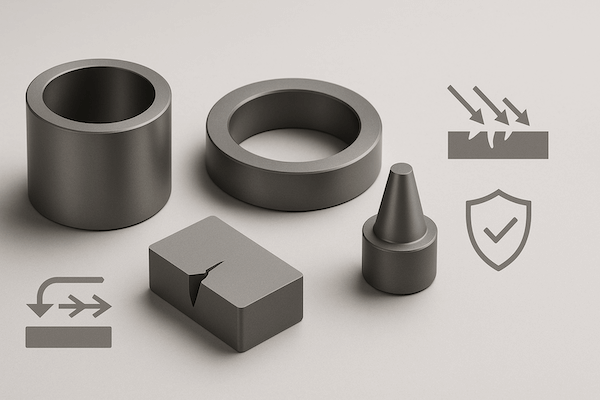
11. What are wear parts tools made of tungsten carbide used for?
Answer: They are used in cutting, drilling, shaping, and forming applications where high hardness and wear resistance are essential, such as in CNC machining, mining drills, and industrial machinery.
12. What types of wear parts are commonly made from tungsten carbide?
Answer: Common types include cutting tools, drill bits, milling tools, dies, punches, grinding wheels, slitting blades, pump components, valve seats, and liners.
13. How does tungsten carbide extend tool life?
Answer: Its superior hardness and wear resistance prevent rapid tool degradation, allowing tools to maintain their sharpness and structural integrity for longer periods, reducing the need for frequent replacements.
14. Can tungsten carbide tools be sharpened?
Answer: Yes, tungsten carbide tools can be sharpened, but it requires specialized equipment and techniques due to their hardness.
15. What maintenance do tungsten carbide wear parts require?
Answer: Regular inspection for wear and damage, proper handling to prevent chipping, and occasional sharpening or reconditioning to maintain performance.
16. Are tungsten carbide tools more expensive than other materials?
Answer: Yes, tungsten carbide tools generally have a higher initial cost compared to tools made from materials like high-speed steel, but their longer lifespan and reduced maintenance can result in cost savings over time.
17. What makes tungsten carbide suitable for high-speed machining?
Answer: Its high thermal conductivity and ability to maintain sharp edges at elevated temperatures make it ideal for high-speed machining applications.
18. How does tungsten carbide improve cutting performance?
Answer: Its hardness allows for cleaner, more precise cuts with minimal wear, reducing the risk of material deformation and ensuring consistent cutting performance.
19. What are the advantages of tungsten carbide over ceramic tools?
Answer: Tungsten carbide offers a better balance of hardness and toughness, making it less brittle and more resistant to chipping and fracture compared to ceramic tools.
20. Can tungsten carbide wear parts be used in wet environments?
Answer: Yes, tungsten carbide is highly resistant to corrosion, making it suitable for use in wet and corrosive environments often found in industries like mining and oil and gas.
Applications in Various Industries
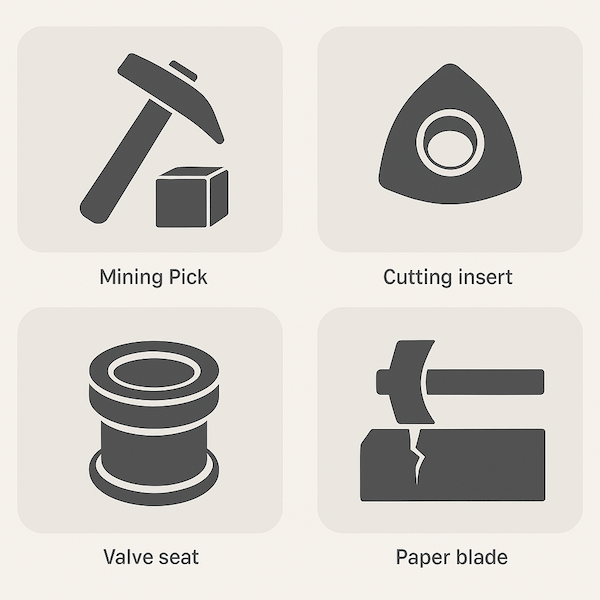
21. How is tungsten carbide used in the mining industry?
Answer: In mining, tungsten carbide is used for drill bits, cutting picks, auger teeth, and wear-resistant liners to enhance drilling efficiency and extend tool life in harsh, abrasive conditions.
22. What role does tungsten carbide play in the oil and gas industry?
Answer: It is used in drilling equipment, pump impellers, valve seats, and flow restrictors to withstand high pressures, corrosive fluids, and abrasive particles, ensuring reliable and efficient operations.
23. Why is tungsten carbide preferred in aerospace manufacturing?
Answer: Its high strength, precision, and wear resistance are crucial for manufacturing high-performance aerospace components that require exacting tolerances and durability.
24. How does tungsten carbide benefit electronics manufacturing?
Answer: Tungsten carbide tools are used for precision cutting, drilling, and machining of delicate electronic components, ensuring high-quality finishes and consistent performance.
25. What is the significance of tungsten carbide in the paper and pulp industry?
Answer: In the paper and pulp industry, tungsten carbide wear parts are used in slitter and cutter blades, refiner plates, and pump components to handle abrasive materials and maintain high production efficiency.
26. How is tungsten carbide utilized in battery manufacturing?
Answer: It is used for cutting, shaping, and drilling battery components like electrode sheets and casings, ensuring high precision, consistent quality, and extended tool life.
27. Can tungsten carbide tools be used in the automotive industry?
Answer: Yes, they are used for cutting, drilling, and machining engine parts, transmissions, and other automotive components that require high precision and durability.
28. What are the benefits of tungsten carbide in metal machining?
Answer: It provides superior cutting performance, extended tool life, reduced downtime, and enhanced precision in CNC lathes, mills, and other metal machining operations.
29. How does tungsten carbide improve construction machinery performance?
Answer: Tungsten carbide wear parts in construction machinery, such as crusher liners and cutting tools, enhance durability, reduce maintenance costs, and improve operational efficiency in demanding environments.
30. Why is tungsten carbide important for high-speed machining operations?
Answer: Its ability to withstand high temperatures and maintain sharpness allows for faster cutting speeds and higher precision, crucial for high-speed machining applications.
Benefits and Advantages
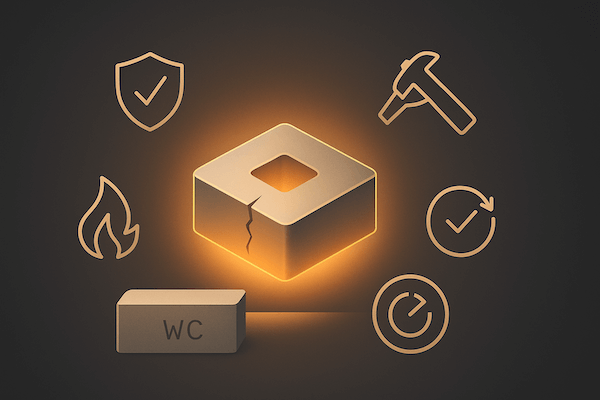
31. What are the main advantages of using tungsten carbide wear parts?
Answer: The main advantages include exceptional hardness, high wear resistance, long tool life, excellent thermal stability, precise cutting performance, and reduced maintenance needs.
32. How does tungsten carbide contribute to cost savings in manufacturing?
Answer: By extending tool life, reducing downtime, minimizing maintenance costs, and decreasing scrap rates, tungsten carbide wear parts lower overall operational costs and improve cost-effectiveness.
33. In what ways does tungsten carbide enhance manufacturing efficiency?
Answer: Its durability and consistent performance enable longer production runs without interruptions, higher cutting speeds, and improved precision, leading to increased overall manufacturing efficiency.
34. Can tungsten carbide tools improve product quality?
Answer: Yes, by maintaining sharpness and precision, tungsten carbide tools produce high-quality, consistent parts with superior surface finishes and minimal defects.
35. How does tungsten carbide reduce environmental impact in manufacturing?
Answer: Its extended tool life reduces material waste and the frequency of tool replacements, while energy-efficient cutting processes lower overall energy consumption, contributing to more sustainable manufacturing practices.
36. What makes tungsten carbide suitable for high-precision applications?
Answer: Its inherent hardness and dimensional stability allow for the creation of tools that maintain tight tolerances and produce precise, accurate cuts necessary for high-precision manufacturing.
37. Does tungsten carbide improve the lifespan of machinery?
Answer: Yes, by providing durable and wear-resistant wear parts, tungsten carbide tools help reduce wear on machinery components, thereby extending the overall lifespan of the equipment.
38. How does tungsten carbide enhance safety in manufacturing environments?
Answer: Reliable and consistent tool performance reduces the risk of tool failures, accidents, and operational disruptions, thereby enhancing overall safety in manufacturing environments.
39. What is the return on investment (ROI) for tungsten carbide tools?
Answer: The ROI is achieved through extended tool life, reduced maintenance and labor costs, increased productivity, and improved product quality, resulting in long-term cost savings and enhanced profitability.
40. Can tungsten carbide tools handle high-temperature applications?
Answer: Yes, tungsten carbide maintains its structural integrity and hardness even under high temperatures, making it suitable for applications that involve significant heat generation.
Purchasing and Supplier Considerations
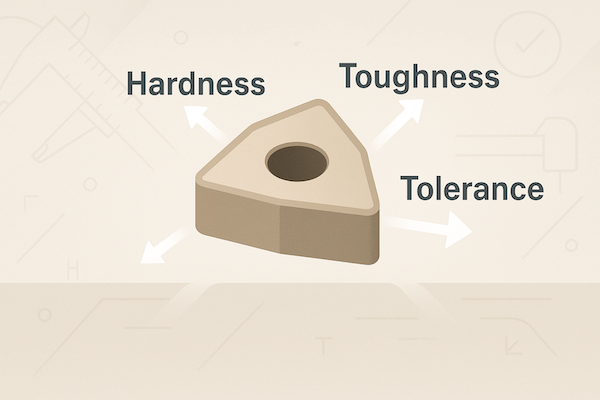
41. What should I look for when purchasing tungsten carbide wear parts?
Answer: Key considerations include the quality and precision of the tools, the reliability and reputation of the supplier, customization options, technical support, and cost-effectiveness with a focus on long-term ROI.
42. How do I ensure the quality of tungsten carbide tools before purchasing?
Answer: Verify certifications, request samples or case studies, check for quality assurance processes, and review customer testimonials to ensure the supplier meets high-quality standards.
43. What certifications should tungsten carbide suppliers have?
Answer: Relevant certifications include ISO 9001 for quality management, industry-specific certifications, and any applicable safety and environmental standards.
44. How important is supplier reputation in purchasing tungsten carbide tools?
Answer: Supplier reputation is crucial as it reflects the consistency, quality, and reliability of the products and services they provide. A reputable supplier ensures dependable supply and high-quality tools.
45. Can tungsten carbide suppliers provide customized tooling solutions?
Answer: Yes, many reputable suppliers offer customization services to tailor tooling solutions to specific manufacturing needs, including adjusting tool geometry, material composition, and coatings.
46. What technical support should I expect from a tungsten carbide supplier?
Answer: Comprehensive technical support may include pre-sales consultation, installation assistance, training, maintenance advice, troubleshooting, and ongoing customer service.
47. How can I assess the ROI of tungsten carbide wear parts?
Answer: Conduct a Total Cost of Ownership (TCO) analysis that includes initial purchase costs, maintenance and replacement costs, productivity gains, and cost savings from reduced downtime and scrap rates.
48. Are there bulk purchasing discounts for tungsten carbide tools?
Answer: Many suppliers offer discounts for bulk purchases or long-term contracts, which can enhance cost-effectiveness and ensure a steady supply of tools.
49. What are the payment terms typically offered by tungsten carbide suppliers?
Answer: Payment terms vary but may include options like net 30, net 60, or other negotiated terms based on the supplier and the volume of the order.
50. How do tungsten carbide suppliers handle shipping and logistics?
Answer: Reputable suppliers have reliable shipping and logistics partnerships to ensure timely and secure delivery of tungsten carbide wear parts, often providing tracking and insurance options.
Technical and Performance Questions
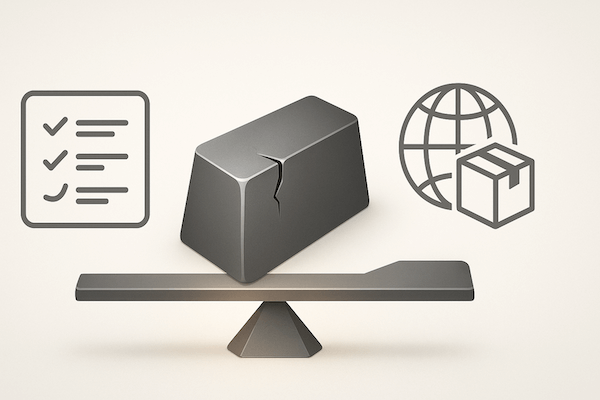
51. How does tungsten carbide perform in abrasive environments?
Answer: Tungsten carbide excels in abrasive environments due to its high hardness and wear resistance, maintaining tool integrity and performance even when exposed to abrasive materials.
52. What are the thermal properties of tungsten carbide?
Answer: Tungsten carbide has excellent thermal stability and high thermal conductivity, allowing it to dissipate heat efficiently and maintain structural integrity under high-temperature conditions.
53. Can tungsten carbide tools be used with different types of machinery?
Answer: Yes, tungsten carbide tools are versatile and can be used with various types of machinery, including CNC lathes, mills, drilling rigs, and specialized manufacturing equipment.
54. What maintenance practices extend the life of tungsten carbide tools?
Answer: Regular cleaning, proper handling to prevent chipping, timely sharpening or reconditioning, and following manufacturer guidelines for use and maintenance help extend tool life.
55. How do coatings affect the performance of tungsten carbide tools?
Answer: Coatings like titanium nitride (TiN) can enhance the hardness, reduce friction, and increase corrosion resistance of tungsten carbide tools, further improving their performance and lifespan.
56. What is the impact of tungsten carbide on machining speeds and feeds?
Answer: Tungsten carbide allows for higher machining speeds and feeds due to its hardness and wear resistance, enabling faster cutting rates and increased productivity without compromising tool life.
57. Are there different grades of tungsten carbide?
Answer: Yes, tungsten carbide is available in various grades, each tailored to specific applications based on factors like hardness, toughness, and thermal stability, allowing manufacturers to select the most suitable grade for their needs.
